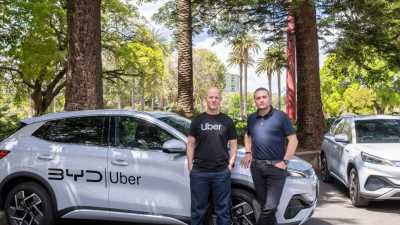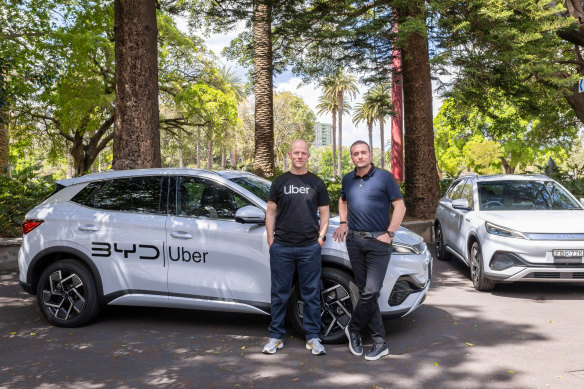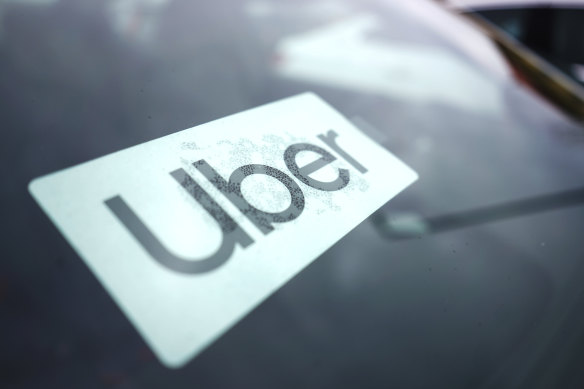Save articles for later
Add articles to your saved list and come back to them any time.
Uber is importing 10,000 electric vehicles from China that it intends to issue to drivers under a rent-to-buy scheme as it accelerates its green ride-share plans.
The vehicles are being imported under a partnership between Uber and EVDirect, the Australian distributor for Chinese electric carmaker BYD.
Uber Australia general manager Dom Taylor and EVDirect chief executive Luke Todd with a BYD electric vehicle.
Drivers can now rent BYD Atto 3 vehicles, which retail from $48,000, from EVDirect. Rent-to-own offers start at $269 a week, leading to outright ownership after four years.
The influx of new electric vehicles, some of which will be sold on to private buyers within as soon as 12 months, is expected to deliver a boost to the second-hand electric vehicle market.
Uber Australia has committed to eliminating emissions from its operations by 2040, banking on business appetite for its guaranteed clean transport offering, badged as Comfort Electric, to kickstart its drivers’ switch from petrol vehicles.
The company’s Uber Green platform allows customers to select a ride from either an electric or a hybrid electric vehicle.
Uber Australia general manager Dom Taylor said the company would provide businesses with data on reduced pollution from using electric vehicles so that they could include it in emissions reporting and calculate the contribution to corporate climate targets.
The price of electric vehicles had fallen sufficiently for them to now be the lowest-cost option for drivers, which would maximise their take-home pay, Taylor said.
“When we ask drivers if they want to upgrade to an EV, two-thirds say yes, but less than 20 per cent say that they think it’s actually likely.
“Our analysis in 2021 showed that was because of the high upfront cost of the car in Australia, and that a hybrid car was a lower-cost option and that was why we saw more hybrids in Australia.
Credit: AP
“We’ve run that same analysis in 2023 using the Atto 3, and it’s at a tipping point where today an EV is the lowest-cost option.”
Uber wants to expand the emissions-free rides to the general public as soon as possible.
There are about150,000 active Uber drivers each month and 2400 electric vehicles currently operating on the Uber ride-share platform.
EVDirect chief executive Luke Todd is banking on his deal with Uber driving sustained growth in new car sales and the second-hand market.
“We believe that 10,000 Uber vehicles switching across to electric is just the beginning,” Todd said. “Once people understand how much money can be saved and how easy it is to transition [to an electric vehicle], we think this will be a tidal-wave movement.”
Drivers can rent a vehicle for one year and EVDirect will take it back and sell it second-hand.
“We’re going to see a huge number of vehicles repurposed and come onto the second-hand [market],” Todd said.
Commuter vehicles generate about 10 per cent of Australia’s annual emissions, and the Albanese government is consulting on a fuel efficiency standard to be imposed from next year.
The policy, which exists in all other developed nations, limits average emissions, measured in grams of carbon dioxide per kilometre, produced by the overall fleet of vehicles sold by a manufacturer to encourage it to sell more EVs.
Taylor said Uber wanted government policy to drive rapid electric vehicle uptake.
“We are hoping to see a powerful fuel efficiency standard coming from the federal government in the next six months as private players like BYD enter the market with bulk low cost,” he said.
Cut through the noise of federal politics with news, views and expert analysis. Subscribers can sign up to our weekly Inside Politics newsletter.
Most Viewed in Environment
From our partners
Source: Read Full Article







